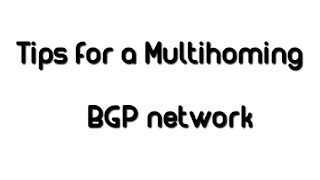Tips for a Multihoming BGP network
I’ve
written about Same
BGP Autonomous System Number in two Datacenters
recently because I wanted to connect two datacenters through Internet
with the same AS Number. However,
I have a new task for these days. I have to add more than one ISP to
the datacenter. Therefore, I will have to configure BGP properly for
several ISPs,
which is an interesting and amazing task. It’s also an advanced
routing task because a configuration
mistake can shut down Internet to customers. I really love
networking.
 |
| Connecting to Two or more ISPs |
Firstly,
it’s important to know how Internet routers view our networks.
There are lots of websites on the net which are useful to know how
other routers can send packets to our networks. There are even
routers where
we can access freely with read-only access to run commands, which are
also useful to see how Internet routes learn our networks. For
instance, there are lots of free access routers in the
www.routeviews.org
website where we can choose a router, access
with the Telnet application and finally run
commands.
 |
| Route Views Project |
Once
we have accessed to a router, we can run commands. It’s important
to know what commands we have to execute as well as we have to
understand the output. The show
ip bgp
command is
the best one to know how other routers view our networks. For
instance, we can run show
ip bgp + network IP address
to know how many paths there are from one router to our network.
We’ll
see all paths and the best path, which is the active path. This
command is useful to see the BGP topology database.
 |
| BGP Topology Database |
The
BGP topology database or BGP forwarding database is a table where all
paths are store. This database is updated by the BGP process and
we can search how routers can send packets to every network in this
database as well as we’ll know attributes such as metric, local
preference, weight, etc.
It’s
important to highlight BGP topology database is different to the
routing table because the routing table only has the best path
instead of all path as
the BGP topology database does.
 |
| Routing Table |
There
is an interesting website I’m used to visiting. The
Réseaux IP
Européens Network Coordination Centre
has lots of resources
about IPv4 addresses,
IPv6 addresses
and autonomous system numbers. For
instance, we can see easily from the www.ripe.net
website how
different routers from Internet see our network. Therefore, it’s
easy to see from this website if our network is advertised through
several ISPs.
 |
| RIPE NCC |
Finally,
if you work as a network engineer, you’ll have to understand
dynamic routing protocols such as BGP properly. If you are going to
advertise your own routes to Internet, you’ll have to know how the
BGP protocol works. If you are not sure what you are doing, the best
option is to contact with professional services.
Best
regards my friends. Keep learning! Drop a
line with the first thing you are thinking!










Commentaires
Enregistrer un commentaire